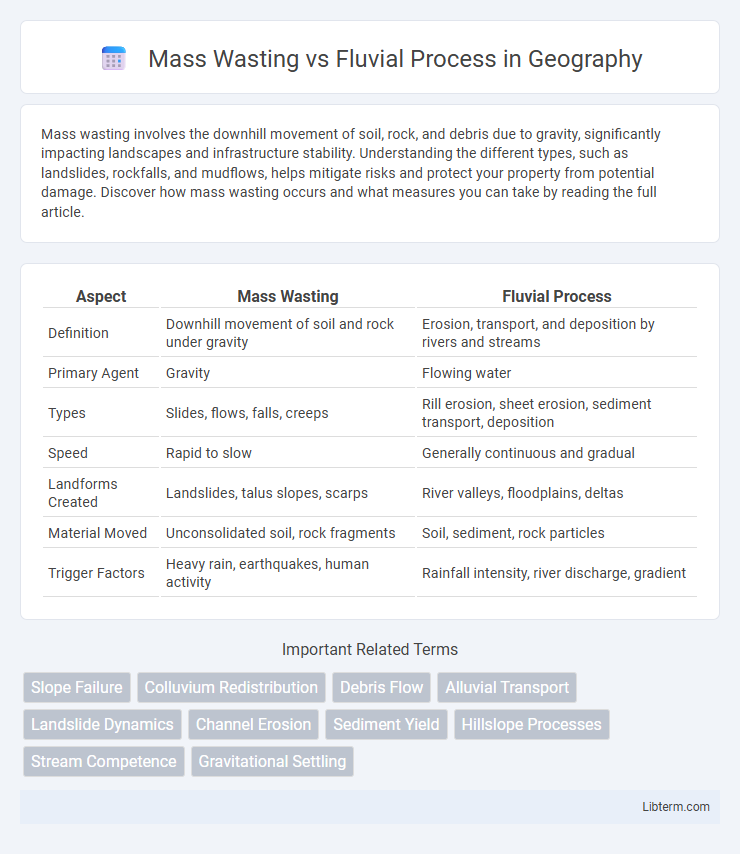Mass wasting involves the downhill movement of soil, rock, and debris due to gravity, significantly impacting landscapes and infrastructure stability. Understanding the different types, such as landslides, rockfalls, and mudflows, helps mitigate risks and protect your property from potential damage. Discover how mass wasting occurs and what measures you can take by reading the full article.
Table of Comparison
| Aspect | Mass Wasting | Fluvial Process |
|---|---|---|
| Definition | Downhill movement of soil and rock under gravity | Erosion, transport, and deposition by rivers and streams |
| Primary Agent | Gravity | Flowing water |
| Types | Slides, flows, falls, creeps | Rill erosion, sheet erosion, sediment transport, deposition |
| Speed | Rapid to slow | Generally continuous and gradual |
| Landforms Created | Landslides, talus slopes, scarps | River valleys, floodplains, deltas |
| Material Moved | Unconsolidated soil, rock fragments | Soil, sediment, rock particles |
| Trigger Factors | Heavy rain, earthquakes, human activity | Rainfall intensity, river discharge, gradient |
Introduction to Mass Wasting and Fluvial Processes
Mass wasting involves the downslope movement of soil, rock, and debris driven by gravity, encompassing phenomena like landslides, rockfalls, and debris flows. Fluvial processes pertain to the erosion, transportation, and deposition of sediments by river and stream systems, shaping valleys and floodplains over time. Both mass wasting and fluvial processes play crucial roles in landscape evolution and sediment dynamics, but they differ fundamentally in mechanisms and environmental settings.
Definition and Key Characteristics of Mass Wasting
Mass wasting refers to the downslope movement of soil, rock, and debris under the influence of gravity, often occurring rapidly without the aid of a transporting medium like water. Key characteristics of mass wasting include the direct gravitational force driving movement, varying speeds from slow creep to sudden landslides, and the absence of a fluid transport agent, distinguishing it from fluvial processes. Unlike fluvial processes that involve erosion, transport, and deposition by running water, mass wasting primarily involves the falling, sliding, or flowing of earth materials along slopes.
Definition and Key Characteristics of Fluvial Processes
Fluvial processes refer to the actions of rivers and streams that shape the landscape through erosion, transportation, and deposition of sediments. Key characteristics include channel flow, sediment load, and the creation of landforms such as valleys, floodplains, and deltas. These processes are driven by water movement and differ from mass wasting, which involves the downslope movement of soil and rock under gravity without the direct involvement of flowing water.
Major Types of Mass Wasting Events
Mass wasting involves the downslope movement of soil and rock due to gravity, with major types including landslides, rockfalls, mudflows, and creep, each characterized by varying speeds and material composition. Fluvial processes primarily shape the landscape through water erosion, transportation, and deposition, influencing river valleys rather than steep slopes prone to mass wasting. Understanding the distinctions between mass wasting events and fluvial processes is critical for assessing geological hazards and landscape evolution.
Main Types of Fluvial Processes
Fluvial processes primarily involve the movement and deposition of sediments through running water, shaping river channels and valleys, and are classified into erosion, transportation, and deposition. Erosion occurs through hydraulic action, abrasion, and solution; transportation includes traction, saltation, suspension, and dissolved load; deposition happens when the river's energy decreases, causing sediments to settle. These processes contrast with mass wasting, which involves the downslope movement of soil and rock under gravity, without the direct action of flowing water.
Triggers and Causes: Mass Wasting vs Fluvial Processes
Mass wasting is primarily triggered by factors such as gravity, slope saturation due to heavy rainfall, earthquakes, volcanic activity, or human disturbances like deforestation and construction. Fluvial processes are caused by the movement of surface water in rivers and streams, driven by precipitation, watershed characteristics, and seasonal flow variations that influence erosion, sediment transport, and deposition. Unlike mass wasting, which involves sudden downslope movement of soil and rock, fluvial processes result in gradual landscape changes shaped by continuous water flow dynamics.
Landscape Impact: Mass Wasting Compared to Fluvial Erosion
Mass wasting drastically reshapes landscapes by rapidly moving large volumes of soil and rock downslope, resulting in steep slopes, scarred terrain, and blocked valleys. Fluvial erosion gradually carves river channels, forming valleys, floodplains, and sediment deposits that reshape landscapes over extended periods. Compared to the sudden, often localized disturbances from mass wasting, fluvial processes produce more continuous and widespread modifications shaped by water flow dynamics.
Human Influence and Intervention
Human activities such as deforestation, urbanization, and construction on unstable slopes significantly increase the risk of mass wasting by reducing slope stability and altering natural drainage patterns. Fluvial processes, meanwhile, are heavily influenced by river channel modification, dam construction, and water extraction, which can disrupt sediment transport and flow regimes. Effective intervention strategies include engineered slope stabilization for mass wasting prevention and sustainable river management practices to maintain fluvial system equilibrium.
Case Studies: Real-World Examples
Mass wasting events exemplified by the 2014 Oso landslide in Washington demonstrate rapid slope failure driven by gravity and saturated soil conditions, causing significant displacement and destruction. Contrastingly, fluvial processes such as the Mississippi River's continual meandering and sediment deposition illustrate gradual landscape shaping through erosion, transport, and sedimentation over time. These case studies underline the distinct mechanisms and temporal scales: instantaneous mass wasting versus progressive fluvial dynamics influencing terrain evolution.
Summary: Distinguishing Mass Wasting from Fluvial Processes
Mass wasting involves the downhill movement of soil and rock due to gravity, characterized by landslides, rockfalls, and debris flows. Fluvial processes refer to the erosion, transport, and deposition of sediments by rivers and streams, shaping valleys and riverbeds over time. Distinguishing these phenomena relies on recognizing mass wasting as gravity-driven, rapid movements, while fluvial processes are water-driven and typically continuous sediment transport mechanisms.
Mass Wasting Infographic

 libterm.com
libterm.com